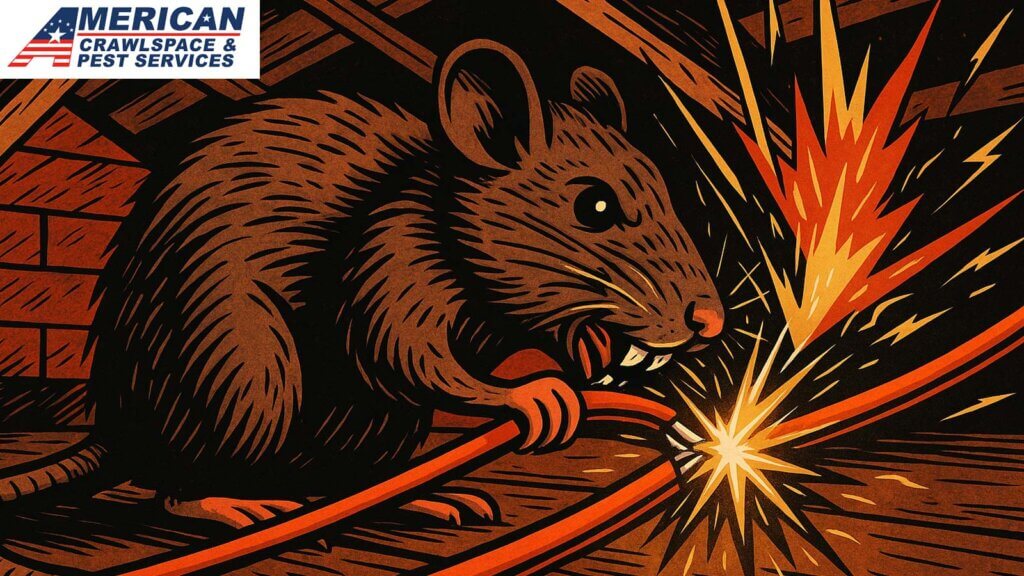Most homeowners don’t think about attic hazards or crawlspace risks—until smoke fills the house or a fire inspection reveals damage. But the truth is simple. Fires often start in forgotten spaces. Rodents chew wires. Old insulation catches sparks. Dryer ducts dump heat and lint into cramped, dusty corners. Left unchecked, these hidden problems can cause real damage.
Let’s break down the top three attic hazards that put your home and family at risk—and how to fix them before it’s too late.
Three Crawlspace and Attic Hazards You Don’t See—Until It’s Too Late
1. Rodent-Chewed Wiring
Why It’s a Big Deal
Rodents love warm, tight spaces. Attics and crawlspaces are perfect nesting spots. But rats and mice don’t just hide—they chew. And when they chew through electrical wires, the results can be catastrophic.
What Happens Next
- Exposed wiring leads to shorts and sparks
- Unnoticed damage can smolder for weeks before igniting
- Circuit overloads become more likely
Many house fires start this way—silent and slow, but deadly. You won’t always see the damage. That’s why routine inspections matter.
What You Can Do
- Listen for scratching sounds overhead or below
- Watch for chewed insulation or droppings
- Have a crawlspace and attic inspection once or twice a year
- If you suspect chewed wires, call an electrician immediately
Our team handles rodent exclusion, sealing up entry points so you can avoid this fire hazard altogether.

2. Old or Damaged Insulation
It Doesn’t Just Waste Energy
Insulation that’s dirty, compacted, or contaminated by pests isn’t just inefficient—it’s flammable. In older homes, you may even find insulation types that no longer meet safety standards. Combine that with heat from lights, ducts, or wiring, and you’ve got a major attic hazard.
Signs Your Insulation Could Be a Fire Risk
- It’s gray, crumbly, or damp
- It smells musty or “off”
- It’s visibly torn, chewed, or thin in spots
- You’ve had a rodent problem before
What You Can Do
- Replace insulation that’s older than 20 years
- Remove any insulation that’s been damaged or contaminated
- Upgrade to fire-rated materials when possible
- Have professionals do the removal—disturbed insulation can release dust, spores, and contaminants
We remove and replace attic insulation every week. If your insulation is past its prime, let’s get it taken care of before it becomes a problem.
3. Improper or Clogged Dryer Ducts
Wait—My Dryer Can Cause Attic Fires?
Yes. Many homes route dryer ducts through the attic or crawlspace. If those ducts are damaged, disconnected, or clogged with lint, the result is a massive fire hazard.
Lint + Heat + Enclosed Space = Trouble
- Dryer lint is extremely flammable
- Warm air from a dryer accelerates the risk
- Loose or leaky ducts send that heat and lint into insulation or wood framing
In some attic fires, dryer ducts were the cause—and the homeowners never saw it coming.
What You Can Do
- Check the full duct run, not just the part behind the dryer
- Make sure ducts are secure, metal (not plastic), and properly routed
- Clean ducts at least once a year—or more if you have a large family
- If your duct runs through the attic, inspect for tears, sagging, or lint buildup
We don’t repair dryer ducts, but during an attic or crawlspace inspection, we can spot the red flags and recommend next steps.
Don’t Wait Until It’s Too Late
Fires caused by attic hazards are preventable. But only if you know what to look for. Most of these risks develop slowly—chewed wires, bad insulation, hidden lint buildup—but they all share one thing: they’re dangerous when ignored.
Book your crawlspace or attic inspection today. We’ll find the trouble before it finds you.
